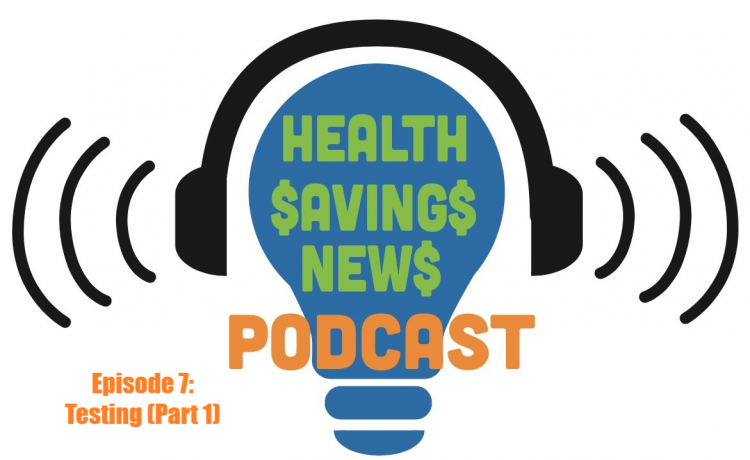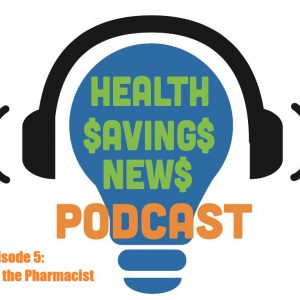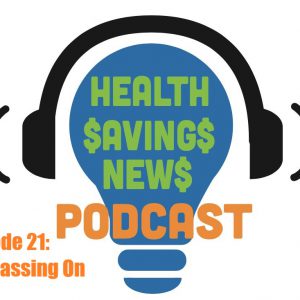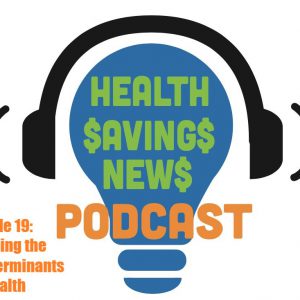Last Updated on November 22, 2022
This a transcript to episode 7 of Health Savings News. In the interest of making the podcast more accessible, we will post transcripts every two weeks as episodes release.
Evan (00:09):
Hello, and welcome to Health Savings News: the podcast about healthcare costs in America and how to save money on the often expensive care all kinds of people need. I’m your host, Evan O’Connor, joined by retired doctors, Rich Sagall and Mike Woods. How’s it going, guys?
Mike/Rich (00:23):
Good./Good to be with you.
Evan (00:25):
Each episode, we discuss healthcare costs in America, offer tips for saving money, and relevant news that affects and reflects the expense landscape of healthcare in America. Today’s topic is testing. The U.S. healthcare system is dominated by a payment system that pays providers for doing tests and procedures. Some patients insist on receiving a test from their doctor, despite not knowing how valuable or not the results could be to their health. In the end, unnecessary tests could contribute billions in wasteful healthcare spending. Upon review of insurance claims from over 1 million patients in Washington state who received one of 47 tests or services that medical experts have flagged as overused or unnecessary, in a single year more than 600,000 patients underwent a treatment that they didn’t need and collectively cost an estimated $280 million. More than a third of the money spent on these tests or services went to unnecessary care. 75% of annual cervical cancer screenings were performed on women who had adequate prior screening at a cost of 19 million. About 85% of the lab tests to prepare healthy patients for low risk surgery were unnecessary wastefully spending about $86 million and needless annual heart tests on low risk patients cost 40 million. So that’s just the numbers from one year in one state. It can be much higher than that, for sure.
Mike (01:44):
We’ll be discussing some of those tests that were deemed necessary in our next session. But today we’d like to focus on understanding just what testing is all about and why patients need to be tested.
Rich (02:00):
I agree that the problem exists of unnecessary tests that are done because of pressure from the patient, and I think it’s part of the healthcare provider’s role to educate people about testing and why you do a test or why you don’t.
Mike (02:14):
And that’s what we’re gonna try to do today. To start off let me emphasize one significant point about testing is a test should only be done if it will help make a decision about your medical care. For no other reason should you be tested. This may include ruling out a diagnosis or explaining any changes in your condition if the history and physical by the doctor is not adequate to do this, and there’s too much uncertainty about the diagnosis to go without testing. Doctors will also do tests to look for results that would change treatment. For instance many diseases are treated where drug levels are very important to the management of the disease. And those levels have to be followed over time. Or there are other labs that are very important to check the progress of your treatment. Two that are well known is the hemoglobin A1C is an excellent way to follow how compliant patients with diabetes have been, and cholesterol checks are a good way to follow whether or not cholesterol medications are working well for you. The last possible reason for testing is for screening that will help to rule out abnormalities and otherwise healthy people that would otherwise have required action and are not diagnosable in any other way.
Rich (03:44):
I would like to add a comment about screening tests. The reason you do a screening test is to find a problem before it causes any symptoms where early treatment makes a difference. And the last part is important. Patients need to consider doing a test if there’s no treatment for what you’re looking for. There may be other reasons to do the test in terms of health planning or life planning, but most screening tests are just for a disease that is asymptomatic in the pre-treatment stage
Mike (04:13):
To me, the most important thing to know about testing is there are a few black and whites when it comes to testing. So very few tests are either yes, you have it, or no, you don’t. So in other words, few tests are conclusive or give the entire picture of an illness. For this reason tests need to be interpreted carefully. And we will discuss that in the future episode about the hazards of using your portal to look up your test results before the doctor has. And it also results in tests being done together to compliment each other. A few examples are, even though an elevated blood sugar can indicate that you have diabetes, you need a hemoglobin A1C to determine how long your symptoms may have been going on for or how well you have been controlling your diabetes treatment over time. Doctors are fond of getting white blood cell counts and see reactive proteins that are very non-specific tests that could indicate infection or inflammation, but the diagnosis can usually not be made until there are bacterial cultures from the suspected sites of infection to confirm the diagnosis.
Rich (05:33):
Couple of points just about that. One is it’s very important to remember you never treat a test, you treat a patient; and you have to take the test results as one piece of information about the patient. The second thing is very often, if a test result doesn’t make any sense in light of the total picture the first thing to do is repeat the test and see if it’s still abnormal.
Mike (05:55):
Yeah, again, we’ll discuss this in the next episode, but I think there’s also room for ignoring the test when it’s completely ridiculous. And again, look at the page and say, that’s a completely inconsistent result and we don’t really need to pay attention to it. What we need to do now, unfortunately, is the very boring coverage of statistics, because statistics are a very important part of testing. And you need statistics to understand why most tests are not yes or no. It would probably surprise you to learn that even normal values are determined by statistics. Lab values vary from person to person and in any given person over time. Well, normal is just a statistical determination that is done when you test a large number of healthy people. Doctors have arbitrarily chosen values between the middle 95% as being the normal values. However, this also means that 5% of otherwise normal people will have abnormal tests. If you think about it, if you have a number of tests that are not actually necessary, it increases the chance of having an abnormal test even though you are really otherwise normal. The more tests you have, the more likely you are to have an abnormal result. Simply multiply the number of tests you have by 5% and after so many tests, you almost have a certainty of having one abnormal result.
Rich (07:33):
And again, that’s why you’d never treat a test. You treat a patient.
Mike (07:37):
The complicated part to understand comes in this next section. Every test that’s been done or that will be done on, you had to be developed at some time and tested to determine either what is the normal range as discussed above or how useful that test might be to diagnose illness. The concept that is used for determining this is called predictive values. Like choosing a normal value, predictive values involved choosing the best cutoff value to indicate a specific disease or condition is present or absent. Aommon example is diabetes. A hemoglobin A1C of 6.5% was arbitrarily chosen as the cutoff for the diagnosis of diabetes. Choosing the cutoff value is a very long and involved process that involves the creators of the test wanting to know how sure they want to be that the test is either present or absent. Those two are actually quite different things about how many inaccurate results are tolerable for the test. So similar to choosing the range of normal cutoffs for tests of being positive or negative may be shown to emphasize the likelihood that the disease is present if the test is positive — which is also known as the sensitivity — or the likelihood that the disease is not present if the test is negative — otherwise known as specificity — and trying to strike a balance between these two while minimizing false positives, which means you have a positive test when the disease is not present or a false negative, which means that the test is negative, even though you might have the disease.
Rich (09:35):
And false positive and false negative may be differently important depending on what type of test you’re doing. If you’re doing a screening test, you’re not as concerned with false positives as false negatives. If you’re doing a more specific test, then you don’t want the false positives.
Mike (09:51):
Said it in another way. If it’s really important that you don’t miss a diagnosis of the patient in front of you, which would be very significant for instance with COVID, cancer, or significant chronic disease, the cutoff is usually chosen such that the disease would not be missed when you take the test. Unfortunate flip side of that is that also means that the test is gonna be positive in a significant amount of times when the disease is not present. If it’s important that everyone with a negative test does not have a specific diagnosis, the cutoff will be chosen so that the test would be negative if the disease is not there, but this also means that there could be false positives when the disease is absent. In both cases, this would result in extra testing that needs to be done to make sure that the person either does or does not have the disease and all of the anxiety involved in waiting for those tests to be repeated.
Rich (10:59):
It’s also important to consider predictive value of the test. So if you look at blood pressure, for example, what we consider normal has changed, but we know that the higher, the blood pressure, the greater the risk of certain diseases. The difficulty is picking a point where we’re gonna say it’s normal where no treatment is necessary and it’s abnormal and treatment is necessary.
Mike (11:21):
Yeah. Predictive values actually figure significantly into lab tests as well. A positive predictive value simply means that if the test is positive, what is the likelihood that you have that disease? For most tests this is nowhere near a hundred percent. As a matter of fact, it’s more likely to be in the 85 to 90% chance. So that means for a test to be positive, it means that there was some chance that you would also miss testing positive even if you have the disease. The opposite of that is the negative predictive value which is the likelihood that a negative results indicates that you don’t have the disease. The same is true there that the likelihoods are usually in the 85 to 95% chance that a negative result may happen even if you have the disease. The last thing we’re gonna discuss in statistics is the P value. While P values are not terribly helpful when determining the outcome of testing, they are very important for determining the treatments that are chosen for patients. The P value is an arbitrarily chosen number that indicates how likely the researcher was when they came to a conclusion about a particular treatment. If you choose a P value of 95%, it means that there’s a 5% chance that that researcher was wrong in making the conclusion that this treatment will work. It’s a very oversimplification of a very complicated statistical topic, but again, it simply boils down to what is the probability that I was wrong when I made the conclusion based on this study.
Rich (13:20):
And I think it’s important. It’s not that the researcher was wrong, it’s that the test results don’t indicate what they thought they indicate. In other words, it falls positive.
Evan (13:30):
We will come back to further explore this topic, how to choose effective testing and how to save money on the often high costs next episode.
[segment break]
Evan:
One of the rotating segments we’ll feature on health savings news is debunking health myths. Health myths and misinformation often spread wider and faster than true, accurate information, and can be harmful to public health. Some myths have circulated for decades. I know Mike has a myth that has been prevalent my whole life and likely much of his as well.
Mike (14:01):
Yeah. And that’s something that we see on television all the time. That always makes me chuckle a little when I see it. But you see the actors in movies or TV shows standing over somebody who had just had a head injury saying, “stay with me, stay with me. You gotta keep awake or something’s gonna happen.” Well, this was a common recommendation decades ago, but in reality now that we fully understand concussions, it really isn’t anything that is really helpful. Even when you look at head injuries, this keeping someone awake was never really meant as a way to prevent you from getting worse. It was always a way to be able to monitor you because when you are awake, you’re more likely to be able to verbalize what’s going on with you. And in fact, if you’re sleepy and can’t stay awake after a concussion, it’s really an indication to get the person to an emergency room as soon as possible, not as a mechanism to keep them from getting worse. If you’re strictly talking about concussions, concussions are rarely very severe or life threatening. So all the medical professionals really need to do is access how alert and oriented you are. And if you’ve been evaluated by a doctor and you have a, a mild concussion or and, and are otherwise, well, just go ahead and sleep away. Nobody really needs to hang around and keep you awake and wake you up every hour. However on the opposite, side sleep is what’s best for you. So in this case, it’s best to the ignore the old myth about keeping awake after concussion or making sure that somebody with a concussion gets woken up every two hours in time to realize that sleep is the best thing.
[segment break]
Evan (16:03):
The last segment of each episode, we suggest some of the culture, art, entertainment, and social causes we’ve been engaged with to each other and our listeners.
Rich (16:11):
I’d like to mention a book that I found very interesting and educational. It’s a book called Overkill: When Modern Medicine Goes Too Far by a physician by the name of Paul Offit Dr. Offit has written a number of books looking at medicine, looking at treatment, looking at how we take care of people. He comes with good credentials. He’s a professor of pediatrics in the infectious disease program at Philadelphia Children’s Hospital. And in this book, he looks at a number of types of treatments that we do and questions whether they’re necessary, whether they should be altered, whether they’re good. Now, some people would say, doctors keep changing their minds on treatments, and we keep changing how we diagnose or what we diagnose and how we treat it. And I would say that’s one of the strengths of medicine. We are always reevaluating what we do, looking for changes, looking for improvements. And I would draw the parallel to someone who has a new job in a 45 minute commute. They may find one route to go and just stick with it. But if they’re really looking at what’s going on, they would look at other ways to get to work and maybe they could find a shortcut or maybe the route depends upon the day, the time of the day, they’re traveling, looking at ways to improve their, their commute by shortening it. And the same thing happens with medicine. I’m sure Mike will give a number of examples of things you learned that you would always do in treating a patient and others you never do many years ago, but now this has changed in some of these. We might never do that, we always did in vice versa. And that’s, as I said, one of the strengths of medicine in this book, doctor offered questions, a number of things that we do. How long do you use antibiotics? When I was in practice, when I first started practice, it was two weeks for an uncomplicated bladder infection in a woman. Then it went to 10 days. Then it went to seven days. Then it went to three days and now there’s one day treatments. So there’s, that’s improvements based upon more, the more that we learn. So again, the name of the book is Overkill.. I highly recommend it to anyone who’s interested in looking at how medicine works and what we do and how we learn to do things better.
Evan (18:20):
Awesome. I have a podcast, it’s called Maintenance Phase hosted by Aubrey Gordon and Michael Hobbs. Their tagline is “wellness and weight loss, debunked, and decoded.” Aubrey Gordon wrote the book. What We Don’t Talk About When We Talk About Fat. It’s an incredibly well researched and entertaining dismantling of body shaming culture, body image related social brainwashing, and a heartfelt deprogramming of all the baggage that comes with that. This is actually a podcast that was recommended to me by a dear friend of mine. And yeah, it’s a great and valuable show I’d suggest to anybody.
Thanks so much for joining us for this episode of Health Savings News. We’ll come back next week with the conclusion of this topic. Please subscribe, rate, and review us on iTunes or wherever you’re listening to the show, it really does help. You can follow @NeedyMeds on Twitter, Facebook, Instagram, LinkedIn, YouTube, and you can follow @HealthSavingPod (no S the end of saving) on Twitter for update specific to this podcast and send questions, comments, or topic suggestions to podcast@needymeds.org. Our music is composed by Samuel Rulon-MIller. His music can be found at musicasadirtyword.bandcamp.com. All the sources we use in our research can be found in this episode’s podcast description on the website or your podcast app of choice. Health Savings News is not intended to substitute professional medical, financial, or legal advice. Always seek the advice of qualified healthcare, professional, or appropriate professional with any of questions. Views, express, and health savings news are solely those of the individuals expressing them. Any views expressed do not necessarily represent the views of Health Savings News, other contributors, NeedyMeds organization, or staff. Thanks again for listening. We’ll see you again in two weeks with the second half of this episode.
Sources:
https://www.propublica.org/article/unnecessary-medical-care-is-more-common-than-you-think
https://modernnurse.com/10-most-unnecessary-and-overused-medical-tests-and-treatments/
https://www.choosingwisely.org/wp-content/uploads/2015/04/Final-Choosing-Wisely-Survey-Report.pdf
https://www.verywellhealth.com/why-does-my-doctor-send-me-for-so-many-medical-tests-2615097





